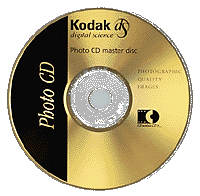Just Burn it to Disk - Not So Fast!
Every Month We Hear from Readers with unreadable
CDs. Here's What You Need to Know to Preserve Your Images.
| The Basics |
How CDs & DVDs Work
|
| Storing Your Disks |
CD & DVD Terms Explained
|
|
Page 1 2
3 Next>>
|
 Burn it to disk. Burn it to disk.
It's a common task in the digital darkroom.
It's how we back up our images and for some of us, how we store them.
For film shooters Photo CDs are their entry into the digital world. Just
about every lab now offers the option of a photo CD when they develop your
film and Kodak even offers a "digital" point and shoot
disposable film camera, the Kodak PLUSDigital, the cost of which includes
having your images put onto disk CD.
But what do we really know about all those shiny silver and gold disks
that clutter our offices? We make the assumption that they'll keep our
images safe for years to come. But how long is that? 5 years? 10 years? 20 years? 50 years? Does it
vary from disk to disk? What about DVD? And is there really a difference
between name brand disks from folks like Kodak, 3M and TDK compared to cheapo
no-name disks at a fraction of the cost?
Each month we get questions from readers on every aspect of
photography. Yet for a long time we received virtually no questions on the
subject of CDs. Yet every day our readers were burning images to disk.
That has changed over the past year as we've heard from more and more
frantic readers with disks full of images they couldn't read. What you
don't know can bite you.
How big of an issue is it? At PhotoPlus I spoke with a Fuji Rep. He
told me that while consumer film sales continue to decline, pro film sales
have seen a sharp increase in the past year. Why? As pros have gotten
burned by disks they couldn't read and high migration costs when upgrading
systems they've reassessed their work flows. Archivally stored slides will
last a lifetime and they can be easily scanned, worked in Photoshop, and
distributed to clients and publishers.
Fuji's response to this trend has been to work with photographers on
creating a digital workflow that includes film. They've also developed a
program to educate their pro market on the process.
|
Tips for Choosing and Storing Disks:
| CD Recordable (CD-R) and DVDR (DVD Recordable) disks
last much longer than rewritable disks (CD-RW or DVDRW). Rewritable disks
may seem like a better bargain than disks that can only be written to
once. But rewritable disks have much shorter lives and are more
sensitive to storage conditions and variations between drives.
Depending on how they are written and stored, rewritable disks can
experience read errors in as little as three to five years. |
| Price = Quality. This is one market where price really does equal
quality. Buy junk disks and they may degrade very quickly. We've heard
anecdotal evidence of cheap CDs that are unreadable after a year. Good
quality disks will cost a little more, but with reasonable archival
precautions they should last over 100 years (see below). |
| Cheap disks have their place. That doesn't mean you should spend a
fortune on disks. Throwaways have their place. Buy the right disks for
the right use. |
| Drives can make a difference. Disks created on an old drive may be
unreadable on a new drive or a new computer. If you're upgrading your
system, go through your old disks and bring up a couple of images off
of each to ensure you can read them before retiring the old computer
to the scrap heap. |
| Take care in storing your disks. A good rule of thumb is if you're
comfortable your disks will be too. Extremes of temperature and/or
humidity will dramatically shorten the life of your disks. |
| Make a Master for Important Data. If a disk contains important images or data make a master disk and a
copy and work from the copy. That will protect the master from the
scratches and damage that are a result of normal handling. |
|
| Picture CDs
vs. Photo CDs - What's the Difference?
Both are formats that may be offered to you by your photo lab
when you get film developed.
Picture CDs are aimed at consumers and "point and
shoot" photographers. They contain one roll of images in JPEG
format and some basic software that allows you to do things like
zoom, crop, remove red-eye, create slide shows, create wallpaper and
print.
The Photo CD format is aimed at the serious photographer. Each
image is stored at 5 resolutions ranging from 128 x 192 pixels up to
2048 x 3072 pixels with an option for a sixth format at 4096 x 6144
pixels. A disk can contain up to 100 images in .PCD (Image Pac)
format and you'll need Photoshop, Paint Shop Pro or similar software
to read the disk. |
 Subscribe to
Vivid Light
Subscribe to
Vivid Light
Photography by email
Tell
Us What You Think
|
